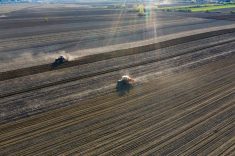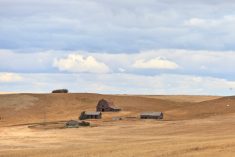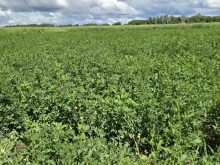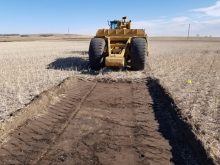Western Canadian farmland has never been more expensive. According to J.P. Gervais, the chief economist for Farm Credit Canada (FCC), which provides data at the national level for Statistics Canada, farmland values continued to increase throughout 2014.
“In a few months the report will be released, but we know that farmland values have continued to increase throughout 2014. The extent of the increase is unsure, but I would suggest that we’ll see something lower than what we saw last year, because last year was a record year,” says Gervais.
Read Also

Claas brings 1000 Series SP forage harvesters to Canada
In mid-August, Claas unveiled its new line of Jaguar forage harvesters at an event in Visalia, California, deep in the heart of that state’s dairy region.
Gervais says local factors have an impact on farmland prices, and at the provincial or national level, two things matter: crop prices and interest rates. “With grains and oilseeds coming down, especially in the last six months, we expect farmland values to go up at a lower pace than we saw last year. That would be a good thing,” he says. “The worst case scenario would be to see the drop in grains and oilseeds that we’ve seen as well as interest rates going up.”
Last year, values went up across Western Canada, but the increase was greatest in Saskatchewan, which was still catching up to the increase in Alberta. Manitoba, he says, is partly influenced by trends in Ontario as well as those in Alberta and Saskatchewan, and as a result has shown rapid increase in the last couple of years.
By historical standards, farmland is priced at the highest level it has ever been. Gervais says that farmland values on average are not unreasonable if you look at crop receipts and low interest rates over the last couple of years.
Potato farming gets expensive
According to Gord Visser, a potato grower near Edmonton, Alta., prices of good potato farmland have skyrocketed over the last several years, to the point where farming is becoming unsustainable for farmers and prohibitive for young farmers hoping to get into the business.
“When I started in 1987 I bought some land for $900 per acre. My best land, where my farm is situated, was $820 per acre. That land is now worth over $25,000 per acre,” he says.
“I can only speak for land in the greater Edmonton area, where there’s a large potato-growing area,” he says. “A lot of the really good agricultural land, especially for potatoes, happens to be located around civic centres like Edmonton, and so with that land there’s a lot of pressure just from growth.”
Visser, a third-generation farmer, says he’s accumulated acres over the years, all of which are paid for, but if his operation were to buy another quarter section, they wouldn’t be able to make that land work for him with regard to capital costs.
“The farms that have old generational equity, because they’ve gained that equity over two generations, they can pool enough money and expand and buy more land,” he says. “I think it’s just about impossible for new farmers to get into the business now.”
A Saskatchewan view
Franck Groeneweg grows spring wheat, Durham wheat, canola, flax, peas and favabeans half an hour northeast of Regina. He started his operation 12 years ago, when fairly, good quality land was selling for between $35,000 and $75,000 per quarter section, or $500 per acre. Lower quality land sold at the time for roughly $300 per acre.
Now, he says, the lower quality land is about $1,500 per acre, and higher quality land is between $2,000 and $2,500 per acre — about four or five times more than in 2003.
He says a number of factors have contributed to the increase. In the 1990s and early 2000s, farmers had poor commodity prices influenced by the U.S. Farm Bill, overproduction of commodities and poor optimism. Additionally, in Saskatchewan, land ownership was restricted to Saskatchewan residents.
“Coming into the late 1990s and early 2000s, the U.S. Farm Bill changed and put more emphasis on subsidies to ethanol, and this created an international demand for grain,” says Groeneweg. Other factors also contributed to this, he says, including increased commodity prices, and the relaxation of land ownership regulations in Saskatchewan to make it available to Canadian citizens regardless of residency. And demand went up.
“All of this generated some decent revenues for farmers, and then once that happened, there was renewed interest from the younger generation,” Groeneweg says. “In the mid-2000s young people came back to the farm. So instead of farms for sale we had farms that were looking for land to buy.”
This means it is much tougher now for young farmers to get started, he says.
The situation in Canada is arguably better than that in the U.S., particularly in the Corn Belt, where land can cost between $15,000 and $20,000 per acre and gross revenue at the farm gate is approximately 10 per cent or less of the highest land costs.
But Groeneweg says the U.S. has much deeper pockets in terms of farm support.
“If we get into a bind, which looks likely, growers in the U.S. will have the ear of their legislatures, but we won’t here in Canada,” he says.
















